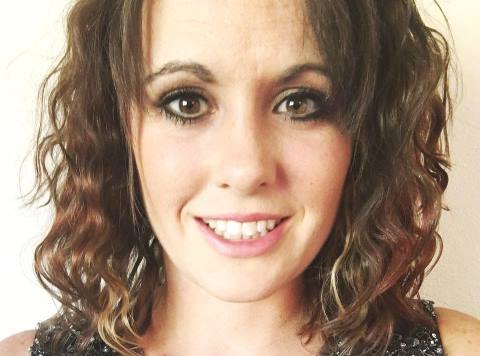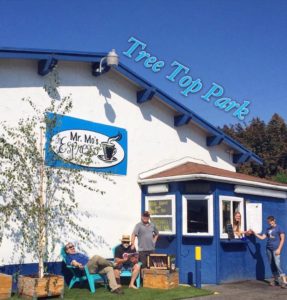This is a story about a community’s experience with their first parklet. It is a story of partnerships forged, people engaged and viewpoints changed. It is a story that touches on revitalization in its many forms, and a story about how a new concept was introduced to a community. But, mostly, it is a story about how one project can set the stage for more in the future and build support within a community to bring those projects to fruition.
My name is Whitney Stohr, and last spring, I made a big decision, to move across the country from where I was living in Washington, D.C., back to my hometown in central Washington—specifically the Yakima Valley, an expansive county with a dominant agricultural economy, located on the “dry side” of the state. (For those unfamiliar with the Washington that exists east of the Cascades, let me tell you now: We are a world away from the more metropolitan “West Side” that includes Seattle and King County.)Following my move, I took a job as Executive Director of a small community organization, known as Selah Downtown Association (SDA), previously run by an all-volunteer Board of Directors. I was the organization’s first staff member.
Selah is a small city of about 7,500 residents, and perhaps best described geographically as a suburb or “bedroom community” of the significantly larger city of Yakima, located just a few miles to the south. First Street, one of the main thoroughfares and an access road to the nearby freeway entrance, passes directly through the city’s downtown district. A large part of the downtown portion of 1st Street is managed by the Washington State Department of Transportation.
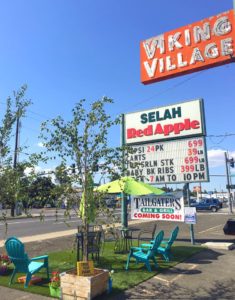 As a result, this arterial road is often treated as a highway rather than an integral part of the downtown corridor. Cars dominate the roadway and travel too fast, often at speeds exceeding 35 and 40 m.p.h., creating an environment that inhibits walkability and pedestrian activity. The drab hues characteristic of highways also dominate many areas of the downtown.
As a result, this arterial road is often treated as a highway rather than an integral part of the downtown corridor. Cars dominate the roadway and travel too fast, often at speeds exceeding 35 and 40 m.p.h., creating an environment that inhibits walkability and pedestrian activity. The drab hues characteristic of highways also dominate many areas of the downtown.
Little green space can be found along 1st Street, and the area could certainly benefit from some high-impact beautification efforts, which are currently under consideration at the municipal level. That is also where SDA comes in!
SDA is part of a state-wide network of non-profit organizations that together form the Washington State Main Street Program. As a Main Street Community, SDA utilizes the tried-and-true “Four Point Approach” for downtown revitalization, developed by the National Main Street Center. These Four Points include Organization, Promotion, Design, and Economic Vitality, which combined, create the foundation that guides Main Street Communities in promoting and advancing downtown revitalization.
Our mission at SDA is to develop and promote downtown Selah as the community’s social, cultural and economic center. By utilizing the Four Point Approach, we work toward this goal by:
- Organizing a team of volunteers and advocates to promote the value of “Main Street” and the importance of revitalization;
- Promoting our downtown and small business community;
- Designing a downtown that is aesthetically-pleasing and that promotes livability; and
- Strengthening the economic vitality of the downtown as a whole.
But, let’s get back to the story at hand.
When I began working at SDA this past March, I was quite fortunate to step into an organization that had already brought together a small, but extremely dedicated group of volunteers. (It was this same group that had done all the work to launch the organization and become recognized as a Main Street Community. Having this level of community support is essential in the work that we do in downtown Selah to achieve our established goals.)
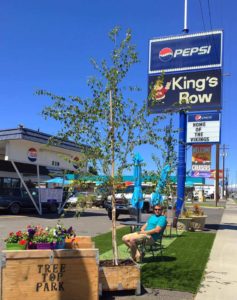 When I first interviewed for the position of Executive Director, I mentioned the concepts of “pop-ups” and parklets as something of personal interest, which I believed would be exciting to implement in Selah. Once hired, Andrew Potter, a board member who also works for the City of Selah as Human Resources Manager and now serves as SDA’s Vice President, approached me in my office and expressed interest in working toward developing a parklet. After some discussion, we settled on the idea of creating a single “pop-up” parklet that would travel around the downtown during the summer months, making several stops at local businesses and city-owned properties. The parklet would stay for 2 to 3 weeks at each location before moving on to the next.
When I first interviewed for the position of Executive Director, I mentioned the concepts of “pop-ups” and parklets as something of personal interest, which I believed would be exciting to implement in Selah. Once hired, Andrew Potter, a board member who also works for the City of Selah as Human Resources Manager and now serves as SDA’s Vice President, approached me in my office and expressed interest in working toward developing a parklet. After some discussion, we settled on the idea of creating a single “pop-up” parklet that would travel around the downtown during the summer months, making several stops at local businesses and city-owned properties. The parklet would stay for 2 to 3 weeks at each location before moving on to the next.
Andrew is a whiz at fine-tuning project details. Before I knew it, he had developed a project proposal and sponsorship request and had contacted Sharon Miracle, Corporate Communications Director at Tree Top, Inc. We met with Sharon in mid-April and were both thrilled when she expressed interest in the project. (At this point, I want to take a moment to, again, thank Tree Top for sponsoring the parklet and for their continuous support of various community programs and events throughout Selah and the greater Yakima Valley.)
With funding from Tree Top, Andrew and I set about designing the space and selecting materials. We initially chose an “apple” theme for the parklet that was characteristic of both Tree Top and the agriculture-based economy on which the Yakima Valley has historically relied. Our first purchase included six 3.5’ x 15’ rolls of artificial grass, which we determined could be reconfigured and manipulated to best fit the space available for the parklet at each location. King’s Row , a local burger joint, loaned us two small tables, and we purchased chairs and large umbrellas to match. Russell Landscaping, also a local company, donated two beautiful, 12-foot-tall birch trees that we planted in small apple bins. Larger apple bins, donated by Spinner Wood Products, yet another local company, were turned upside-down to create additional seating room and board game tables. The words “Tree Top Park” were painted on their sides.
And with that, the parklet was ready for installation.
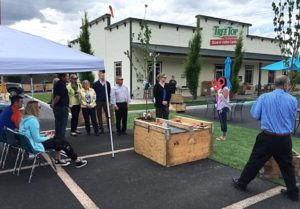 We held a ribbon-cutting ceremony on Friday, May 20, 2016, at the Tree Top Store & Visitor Center. The mayor of Selah attended, as did local council members, city staff and SDA board and committee members and volunteers. A reporter from the local Yakima Herald-Republic newspaper also attended and published a nice article about the parklet the following day, titled “Selah’s ‘pop-up’ park shows residents what downtown can be” (5/21/2016).
We held a ribbon-cutting ceremony on Friday, May 20, 2016, at the Tree Top Store & Visitor Center. The mayor of Selah attended, as did local council members, city staff and SDA board and committee members and volunteers. A reporter from the local Yakima Herald-Republic newspaper also attended and published a nice article about the parklet the following day, titled “Selah’s ‘pop-up’ park shows residents what downtown can be” (5/21/2016).
It was at that point, with such a significant showing of support from community leaders, that we realized that this project had to succeed. We wanted the project to have a meaningful impact on the city and leave a positive impression, and that meant our work had really just begun…
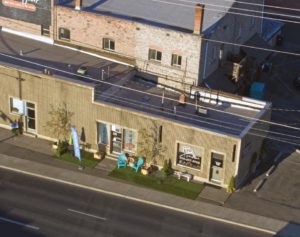 At its core, the parklet was meant to be a conversation-starter. The underlying goal was to get people thinking about city beautification and considering improvements to increase livability in our downtown and surrounding areas. We hoped that, as the parklet traveled from one location to the next, business owners and residents would come to better understand and value beautification projects that contribute to the city’s design and aesthetics. Changing public perception of the downtown and encouraging people to consider what “could be” in Selah were thus two important goals from the project’s outset.
At its core, the parklet was meant to be a conversation-starter. The underlying goal was to get people thinking about city beautification and considering improvements to increase livability in our downtown and surrounding areas. We hoped that, as the parklet traveled from one location to the next, business owners and residents would come to better understand and value beautification projects that contribute to the city’s design and aesthetics. Changing public perception of the downtown and encouraging people to consider what “could be” in Selah were thus two important goals from the project’s outset.
Community engagement was another goal. As a Main Street Community, SDA’s mission is to improve downtown Selah, both in terms of overall design and the degree of public interaction with those designed elements and with each other as fellow residents. This goal of increased community engagement required broadening the concept of the traveling parklet beyond that of simply an educational piece. In our minds, it was not enough to create a parklet “for show.” We wanted people to actually interact and utilize the parklet as a public amenity. Now, we understood from the beginning that this would require creativity on our part. We had to find a way to widen the public’s view of the parklet beyond seeing it as a novelty beautification project, and rather as something that was created for their use and benefit.
In many ways, community engagement is a more difficult goal than altering community perception alone. One can go far in influencing perception through individual actions that place a project in public view and show in a visual way the benefits of change. In that case, you are doing all the work. You are asking no more than that people look at the project and consider with an open mind what it might mean on a larger scale or extended timeline. Actual engagement, on the other hand, requires asking other people to do something. It requires effort on the part of others, which cannot be forced, although the outcomes and experiences derived from those efforts, when they do occur, are significant.
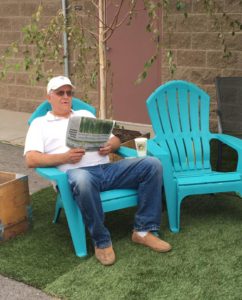 For instance, residents who observed the parket from a passing vehicle experienced the project in a different manner than those who actually got out of their vehicles and visited the parklet. Perhaps the perception of the former resident was altered; perhaps they now view such projects in a more positive light or with greater understanding of their purpose. But, it is truly the resident who visited the parklet—who engaged with the project on an individual level—who likely walked away having had a more impactful experience.
For instance, residents who observed the parket from a passing vehicle experienced the project in a different manner than those who actually got out of their vehicles and visited the parklet. Perhaps the perception of the former resident was altered; perhaps they now view such projects in a more positive light or with greater understanding of their purpose. But, it is truly the resident who visited the parklet—who engaged with the project on an individual level—who likely walked away having had a more impactful experience.
As a project manager, you can encourage engagement and create opportunities for people to engage, but the true action of engagement itself must come from the individual community members. Thus, our challenge with the parklet project was in findings ways to push through that boundary between passive experience and direct engagement.
So, from the beginning, there were lingering questions: How can we successfully achieve direct engagement with the parklet? What can we do to ensure that the project is seen as a valuable public amenity, rather than simply something “to be seen” only?
 We settled on a two-pronged approach. First, we had to raise awareness about the project. We had to ensure that the public knew what the parklet was, its purpose and goals, and that they could identify the parklet when they saw it. As the community’s first parklet, this was, for many people, the first time they had heard about the design concept and their first experience with any type of temporary, park installation. This meant investing time in public education and outreach, and social media played a large role. Information and photographs of the parklet were continuously uploaded and shared and, as summer rolled on, a growing number of our followers on social media also began to share these photographs and comment on our posts.
We settled on a two-pronged approach. First, we had to raise awareness about the project. We had to ensure that the public knew what the parklet was, its purpose and goals, and that they could identify the parklet when they saw it. As the community’s first parklet, this was, for many people, the first time they had heard about the design concept and their first experience with any type of temporary, park installation. This meant investing time in public education and outreach, and social media played a large role. Information and photographs of the parklet were continuously uploaded and shared and, as summer rolled on, a growing number of our followers on social media also began to share these photographs and comment on our posts.
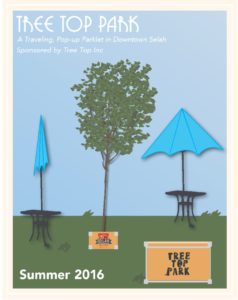 To reach those not active on social media, we shared information about the parklet in our monthly e-newsletter, at city council meetings, and at meetings of other community groups. We also set our student graphic design intern to work creating a “special edition” Tree Top Park poster that we could give away at meetings and special events and to business owners to post in public view.
To reach those not active on social media, we shared information about the parklet in our monthly e-newsletter, at city council meetings, and at meetings of other community groups. We also set our student graphic design intern to work creating a “special edition” Tree Top Park poster that we could give away at meetings and special events and to business owners to post in public view.
There was never a point during this project when we stopped looking for new ways to promote it and to share its successes. For example, SDA volunteers decorated the parklet in red, white and blue ahead of the city-wide Independence Day celebration, hosted a month-long “Tree Top Park Selfie Contest,” and worked with a local drone pilot and member of the City of Selah police force to capture aerial footage and photographs of the parklet at different locations downtown.
In addition to awareness-raising, the second part of our plan was to create engagement opportunities. Of course, people were free to use the parklet on their own time; but, in addition, we sought to create unique opportunities that would draw residents downtown to visit Tree Top Park and whatever local business was hosting the parklet at that time. The value of these events were three-fold. First, they brought people to the parklet and provided that opportunity for direct engagement. Second, they generated additional content that we used to further raise awareness about the parklet. And third, they drew potential customers to the host business and, in doing so, reinforced the economic benefit of beautification projects and community engagement by small businesses.
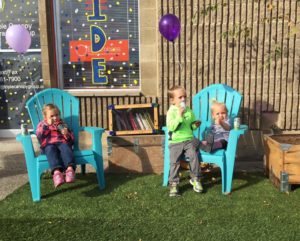 SDA hosted at least one event at Tree Top Park at each location and encouraged business owners to utilize the space for their own events. In August, for instance, SDA welcomed members of the local Selah Chamber of Commerce to Tree Top Park for a “Business After Hours” event and, in addition, invited the public to join in for a community “Root Beer Float Social.”
SDA hosted at least one event at Tree Top Park at each location and encouraged business owners to utilize the space for their own events. In August, for instance, SDA welcomed members of the local Selah Chamber of Commerce to Tree Top Park for a “Business After Hours” event and, in addition, invited the public to join in for a community “Root Beer Float Social.”
Some business owners also responded positively and hosted their own events at the parklet. For example, in July, Nana Kate’s, a local café and eatery, threw a summer “Beach Bash” during the parklet’s time at her business, and staff from the Selah Public Library hosted an end-of-summer “Splash Party” in late August for kids heading back to school.
 To further encourage community engagement, SDA periodically changed the visual elements of the parklet—such as adding Adirondack chairs and other seating options—and incorporated additional engagement tools, including a pop-up, miniature library. Often, the installation of these elements became small events in themselves with SDA volunteers on hand to help and others passing-by stopping to see what all the excitement was about.
To further encourage community engagement, SDA periodically changed the visual elements of the parklet—such as adding Adirondack chairs and other seating options—and incorporated additional engagement tools, including a pop-up, miniature library. Often, the installation of these elements became small events in themselves with SDA volunteers on hand to help and others passing-by stopping to see what all the excitement was about.
SDA officially “retired” the parklet in mid-October 2016. As with any new project, we learned several important lessons about what works and what does not in terms of parklet design, planning and management. However, without a doubt, those actively involved with SDA, myself included, consider Tree Top Park a resounding success for our organization and for the city as a whole.
During the life of the parklet, between May and October, hundreds of community members attended events held at Tree Top Park, and thousands interacted with the parklet in other ways, at city-wide events such as the Independence Day celebration or the Autumn Festival, or by simply driving by the parklet during their travels around town. During this period, we also noticed a shift in the public’s perception of the parklet. The type of disagreeable messages received in the weeks following the parklet’s installation from those upset about its interference with parking or questioning the use of funds to create Tree Top Park, ceased entirely by the end of the summer.
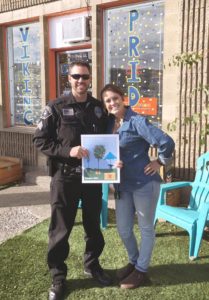 Instead, we received dozens of messages in support of the parklet and many inquiring about a plan for future parklets and annual installations.
Instead, we received dozens of messages in support of the parklet and many inquiring about a plan for future parklets and annual installations.
For me personally, more than anything else, I enjoyed seeing this change, the growth of the community, and the broadening of public knowledge about downtown revitalization, the benefits of green space, and the importance of considering “liveability” when designing and improving our city.
Truly, this project was about more than simple beautification; it was a meaningful step in a small community’s path forward — toward both physical and economic revitalization, and most importantly, the revitalization of community spirit, civic pride and public engagement on Main Street.
About the Author:
 Whitney Stohr is the Executive Director of Selah Downtown Association, a non-profit organization and member of the Washington State Main Street Program. Whitney is originally from Yakima, Washington, and specializes in non-profit management, community and economic development, historic preservation and environmental policy and sustainability. She holds degrees from the University of Montana (B.A. Political Science), the University of Florida (M.S. Ecological Restoration), Gonzaga University School of Law (J.D.), and The George Washington University School of Law (LL.M. International & Comparative Law). She currently lives and works in the Yakima Valley.
Whitney Stohr is the Executive Director of Selah Downtown Association, a non-profit organization and member of the Washington State Main Street Program. Whitney is originally from Yakima, Washington, and specializes in non-profit management, community and economic development, historic preservation and environmental policy and sustainability. She holds degrees from the University of Montana (B.A. Political Science), the University of Florida (M.S. Ecological Restoration), Gonzaga University School of Law (J.D.), and The George Washington University School of Law (LL.M. International & Comparative Law). She currently lives and works in the Yakima Valley.

